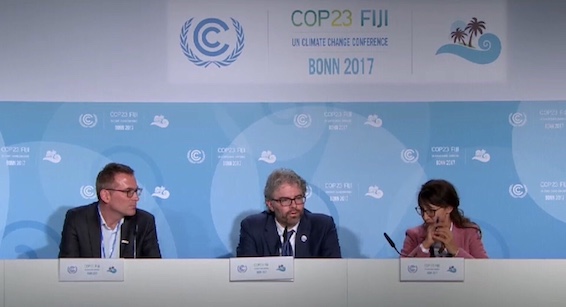
CCL Global Policy Director Joe Robertson (center) at COP23
By Steve Valk
President-elect Joe Biden comes into office with an ambitious agenda to tackle climate change. How much of that agenda is achievable, however, depends on the outcome of two Senate runoffs in Georgia on Jan. 5. Democrats would need to win both seats to wrest control of the Senate from Majority Leader Mitch McConnell, who has shown little inclination to support Biden’s climate efforts. Even if Democrats succeed in the Georgia runoffs, the Senate would be divided 50-50, virtually guaranteeing that any legislation will need bipartisan support for passage.
One effective policy that appeals to both Democrats and Republicans is a fee on carbon with revenue distributed to households. And should McConnell retain control of the Senate, there is one other factor that will put pressure on him to consider a price on carbon: Europe’s border carbon tax, which would penalize U.S. manufacturers for America’s lack of a carbon price.
One of the three pillars of CCL’s carbon fee and dividend policy proposal is a border carbon adjustment on imports from nations that don’t have an equivalent price on carbon. The adjustment would protect American businesses from unfair competition, maintaining a level playing field for U.S. manufacturers. It would also create a strong incentive for other nations to follow our lead and implement carbon pricing policies of their own.
The European Union, however, is beating America to the punch by imposing a border carbon tax of its own, due to go into effect in 2023. With U.S. exporters facing the likelihood of honest levies on the carbon footprints of their goods, the tables would be turned, and the U.S. would have a strong incentive to enact a price on carbon.
CCL’s VP for Government Affairs Danny Richter thinks the pressure would be substantial. “If you add up all the countries in the EU, they have the second largest economy in the world. So, the second largest economy in the world is going to have a border carbon adjustment.”
A Border Carbon Adjustment (BCA) was included in the Energy Innovation and Carbon Dividend Act because bill sponsors recognized that a fee on carbon would impose an additional production cost on U.S. manufacturers. Companies in other countries that don’t bear that added cost would be able to make and sell their goods at a lower price, putting American firms at a competitive disadvantage. The BCA maintains American competitiveness on the international stage.
In addition, the BCA would also be a disincentive for American manufacturers to “offshore” their carbon emissions by moving production — and jobs — to nations that don’t hold polluters accountable for their emissions.
Europe stepping up climate ambition
While Congress sits on legislation like the Energy Innovation Act, Europe is moving ahead with a comprehensive plan to make the 27-nation EU carbon neutral by 2050, a plan called the European Green Deal.
With the goal of reducing emissions from 1990 levels by at least 55% by 2030, the EU’s ambitious plan will spend a trillion euros in the coming decade to invest in environmentally friendly technologies, support industry to innovate, decarbonize the energy sector and ensure buildings are more energy efficient, among other measures.
The EU’s Emissions Trading System (ETS), a carbon-pricing mechanism that employs cap and trade, will also get an overhaul, with a tighter cap on trading permits and a steeper rate of decline on those caps. The tighter cap will push permit prices higher than the current 26 euros ($30) per ton of CO2, and prices will continue to rise as the cap tightens.
As sponsors of the Energy Innovation Act realized, EU policymakers acknowledge that the European Green Deal will impose added costs for manufacturers.
Aaron Cosbey, co-author of a study published by the European Roundtable on Climate Change and Sustainable Transition, told Bloomberg, “Europe is moving on emissions, and it can’t do that without an instrument that addresses competitiveness.”
Europe’s border carbon adjustment
To maintain competitiveness, the EU committed this summer to imposing a Border Carbon Adjustment mechanism by 2023. Details of the mechanism will be worked out in the coming year.
Bloomberg reported “the most probable design of the border adjustment would encompass extending the EU Emissions Trading System into imports of selected products, such as cement and electricity.”
The adjustment mechanism will not cover all imports, but likely be applied to what is known as energy intensive-trade exposed products. These are goods that require a great amount of energy to produce and are heavily traded throughout the world — cement, steel, aluminum, chemicals, cars and fossil fuels, for example.
One interesting side note here is the possibility that European carbon pricing could go far beyond tweaking their cap-and-trade system. CCL Global Strategy Director Joe Robertson said interest in carbon fee and dividend is picking up, and CCL volunteers in Europe are at the forefront of that conversation.
Although the EU cannot levy taxes, Robertson says Europe could follow the Canadian model of passing a regulation that would require member nations to implement a carbon price that meets certain standards.
“The Canadian model is a central government policy. There’s a standard. If you don’t have any policy, then this is the standard that you will automatically be expected to enforce. If you don’t enforce it, we’ll enforce it for you and what you lose as a provincial government is that the money goes to Ottawa, not through your own internal treasury,” said Robertson.
Europeans could follow Canada’s approach, and failure by nations to come up with a carbon-pricing policy would trigger a default policy established by the EU.
Effect on U.S. manufacturers
Whether cap-and-trade or fee-and-dividend, one thing is certain: Europe plans to protect its businesses with a border adjustment, and that will have an impact on American exporters.
If Congress were to enact a fee-and-dividend policy with a price that matched or exceeded Europe’s, American exporters with goods subject to the border adjustment could be exempt from the European levy.
But what if the U.S. did not implement a carbon price but reduced emissions through regulations and other measures like subsidies and renewable energy standards? Would U.S. companies be exempt from Europe’s border adjustment by virtue of the fact that the U.S. is reducing emissions by other means?
“Probably not,” said Richter.
Without knowing the details of Europe’s BCA, it’s difficult to answer the question. The absence of a U.S. carbon price, however, would make it extremely difficult and complicated to calculate the equivalency between American and European products. Regulations and their costs to manufacturers vary widely from country to country, making it hard to compare the costs absorbed by domestic and imported products. A price on carbon, however, provides a straightforward metric for assessing the levy to apply on imports.
Alexandros Kazimirov, a graduate student at UC Berkeley and one of the associates working with CCL Governing Board Chair Ross Astoria, elaborates on the difficulty of avoiding Europe’s border adjustment without a carbon price:
“It is nearly impossible to apply identical policy and expect the same result in different circumstances. Even in the best case scenario, there is always some marginal variance in regulatory frameworks. If the U.S. adopted some measures, this would not exempt our exporters from the European BCA on its own. It is instead important to establish that the measures taken by the U.S. contribute to a ‘fair transposition of climate effort’ and ‘climate policy convergence.’ The first means we are doing our share of contributions. The second means we are foreseeable, reliable, predictable. Once these two points are communicated to the EU, Congress can — hopefully — arrange for a waiver of the European BCA. Rejoining the Paris Agreement would help make this argument, too.”
Should the U.S. choose to reduce emissions without a carbon price, American manufacturers will still absorb additional costs from regulations and higher energy prices resulting from renewable energy standards. Imports from nations that don’t match the U.S. ambition on climate change will have lower costs, and therefore a competitive advantage against U.S. firms. The only way to maintain a level playing field is with a border carbon adjustment. Again, in the absence of a carbon price, the imposition of a BCA looks very doubtful.
In a piece posted on the Niskanen Center’s website, climate policy analyst Shuting Pomerleau, questioned the viability of a border adjustment in the absence of a carbon tax:
From a legal perspective, levying carbon tariffs in isolation could violate World Trade Organization (WTO’s) non-discriminatory rules. Jennifer Hillman, a former member of WTO’s Appellate Body, commented on a POLITICO online event that carbon border taxes would need to be equivalent to the ones domestic producers are facing to be compliant with the WTO rules.
CCL Research Coordinator Jerry Hinkle was of a similar mind. “If we raise manufacturing costs through a carbon tax, we can institute a BCA, but if we raise costs through regulations like a Clean Energy Standard, it’s unlikely we can. If we use regulations as opposed to a price, it’s hard to protect U.S. competitiveness with a border carbon adjustment.”
CCL’s Richter concurred: “[The BCA is] much simpler to do with a fee or tax in the first place. If you want businesses to have stability and predictability and to be competitive, you’re gonna have to do this. And so I think it’s really good that Europe is doing this. I think that it really makes our job easier.”
Without the protection of a BCA, some U.S. manufacturers may move production overseas. Presidential-elect Joe Biden has promised to bring back manufacturing jobs in the U.S., but cheap competition from other countries could thwart that goal. A border adjustment would ensure that U.S. action to rein in climate change doesn’t clash with the aim of increasing manufacturing jobs.
Incentive for other nations
Finally, let’s look at the bigger picture of what it’s going to take to keep global warming from exceeding 2 degrees Celsius (preferably 1.5C) and how a border carbon adjustment could assist that effort.
When the Paris Climate Agreement was signed in 2015 by 196 countries, it was acknowledged that the initial commitments would be insufficient to hold warming to 2C, let alone 1.5C. The United Nations Environmental Programme estimates that if current commitments are met, global average temperatures will increase 3.2C by the end of the century. And that’s if current goals are being met, which they are not.
While it’s encouraging that Europe is making a huge commitment in upping their game to protect the climate and that prospects in the U.S. are looking better, together they account for only one fourth of CO2 emissions globally. The rest of the world must do its part, too. Although eight of the world’s top 10 economies have a carbon price, only 22.3 percent of global emissions are covered by a carbon price. Europe and the U.S. can leverage their economic power to motivate other nations to take stronger measures on reducing carbon pollution. Border carbon adjustments from the EU and the U.S. can be the catalyst for effective carbon pricing throughout the world.
But without a carbon price and BCA, the U.S. has little leverage to influence policies in other countries.
In the U.S., there’s a false narrative that we must choose either the Green New Deal or carbon pricing. Europe is showing you can make progress with multiple policies: Invest big in green technologies AND put a price on carbon.
An ambitious carbon fee and dividend with border adjustments will…
- Accelerate the transition to clean power and transportation
- Add income to households at a time when nations will be recovering from a COVID-induced recession
- Protect American businesses and help the U.S. retain manufacturing jobs
- Leverage U.S. economic strength to increase the climate ambition of other nations
It’s time for the U.S. to reclaim the mantle of leadership on climate change. A carbon price with a border carbon adjustment is an indispensable tool for making that happen.




